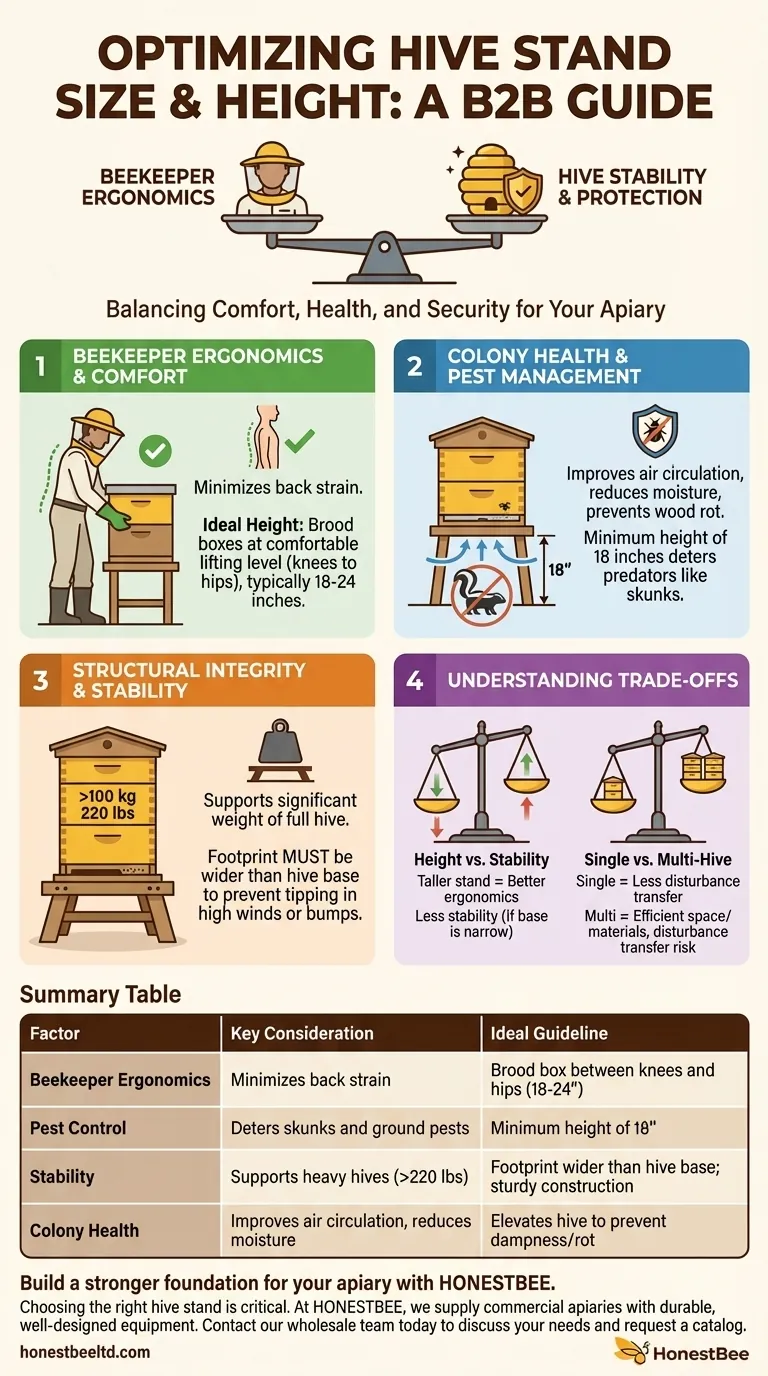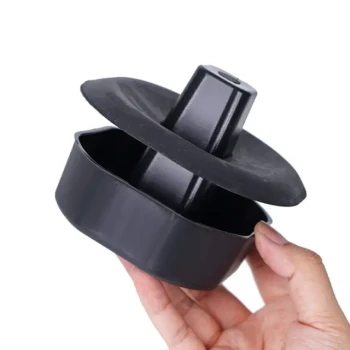Ultimately, a hive stand's size and height are dictated by two primary factors: your physical comfort as the beekeeper and the hive's need for stability and protection. The ideal stand is high enough to save your back from strain during inspections but has a footprint wide and stable enough to support the significant weight of a full hive without any risk of toppling.
The most effective hive stand is not a standard, one-size-fits-all product. It is a calculated balance between beekeeper ergonomics and the fundamental safety, health, and security requirements of the bee colony.

The Purpose of a Hive Stand
A hive stand is more than just a platform; it's a critical piece of equipment that directly impacts your hive's success and your enjoyment of beekeeping. Its dimensions influence everything from pest management to your own physical well-being.
Beekeeper Ergonomics and Comfort
The height of your stand is primarily about you. Bending over a low hive to lift heavy boxes full of honey is a direct path to back strain.
A well-chosen height places the heaviest boxes (the brood boxes) at a comfortable lifting level, roughly between your knees and hips. This minimizes stress on your back and makes hive inspections significantly easier and safer.
Colony Health and Pest Management
Raising the hive off the ground provides several benefits for the bees. It improves air circulation, which helps reduce moisture buildup and prevent the wood from rotting.
Crucially, a height of at least 18 inches deters common predators like skunks, which can harass a hive by scratching at the entrance. It also creates a barrier against ground pests and reduces the chance of dampness seeping in from the ground.
Structural Integrity: Strength and Stability
A mature hive during a peak honey flow can easily weigh over 100 kg (220 lbs). The stand’s primary job is to support this weight without fail.
Because hives become very top-heavy when honey supers are added, stability is just as important as raw strength. The stand's footprint must be wide enough to prevent any chance of tipping over in high winds or if accidentally bumped.
Workspace and Accessibility
The stand's "size" also refers to the surface area. It should be slightly larger than the hive's base to provide a secure platform.
You also need enough space around the hive to work comfortably. This means you should be able to place tools, a new hive box, or the roof on the stand beside the hive during an inspection without feeling cramped.
Understanding the Trade-offs
Choosing the right dimensions involves balancing competing factors. What is best for one goal might be a compromise for another.
Height vs. Stability
A taller stand is better for your back and for deterring pests. However, the taller the stand, the higher the hive's center of gravity, which can potentially reduce stability if the stand's base is not sufficiently wide and level.
Single-Hive vs. Multi-Hive Stands
A long stand designed for multiple hives is an efficient use of space and materials. The downside is that vibrations and disturbances from inspecting one hive are easily transferred to its neighbors, which can agitate the other colonies.
Material Choice vs. Durability
A simple stand of cinder blocks is cheap and incredibly stable but offers limited height. A custom-built wooden stand can be tailored to the perfect height and size, but requires more effort and proper weather treatment to ensure a long lifespan.
Making the Right Choice for Your Goal
Select your stand dimensions based on your primary objective for your apiary.
- If your primary focus is personal comfort and ergonomics: Choose a stand that raises the bottom brood box to your mid-thigh, typically between 18 and 24 inches.
- If your primary focus is hive security and pest control: Prioritize a height of at least 18 inches and ensure the stand is made of sturdy, immovable materials.
- If your primary focus is a simple, low-cost start: Use four cinder blocks to create a stable, weather-proof base that keeps the hive off the ground, and plan to upgrade later for better ergonomics.
A well-designed hive stand is the foundation for a healthy colony and a sustainable beekeeping practice.
Summary Table:
| Factor | Key Consideration | Ideal Guideline |
|---|---|---|
| Beekeeper Ergonomics | Minimizes back strain during inspections | Height places brood box between knees and hips (18-24 inches) |
| Pest Control | Deters skunks and ground pests | Minimum height of 18 inches off the ground |
| Stability | Supports heavy hives (220+ lbs) without tipping | Footprint wider than hive base; sturdy, level construction |
| Colony Health | Improves air circulation, reduces moisture | Elevates hive to prevent dampness and wood rot |
Build a stronger foundation for your apiary with HONESTBEE.
Choosing the right hive stand is critical for the safety of your bees and the efficiency of your operation. At HONESTBEE, we supply commercial apiaries and beekeeping equipment distributors with durable, well-designed hive stands and other essential equipment built to withstand the demands of professional beekeeping.
Let us help you protect your investment and streamline your workflow. Contact our wholesale team today to discuss your needs and request a catalog.
Visual Guide

Related Products
- Plastic Bee Hive Stand for Beekeeping
- Professional Engraved Round Hive Number Tags for Beekeeping
- Professional Ant-Proof Beehive Stand with Integrated Moat for Beekeeping
- Wholesales Dadant Size Wooden Bee Hives for Beekeeping
- Professional Galvanized Hive Strap with Secure Locking Buckle for Beekeeping
People Also Ask
- Why is it important to level a hive stand properly? Prevent Catastrophic Failure & Ensure Hive Health
- Why is elevating the hive important? A Simple Step for a Healthier, More Productive Colony
- How do bees regulate ventilation and temperature in the hive? Master Hive Climate Control
- How do bees regulate the temperature of their hive during the summer? Discover Their Natural Cooling System
- What are the advantages of polystyrene hives for beekeeping? Boost Colony Health & Honey Yields



















